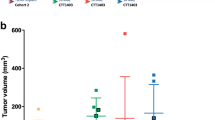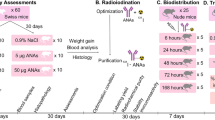Abstract
Purpose
The purpose of this study was to assess the therapeutic and toxicological effects of cesium chloride (CsCl) administration in mice bearing prostate cancer tumors.
Methods
Three CsCl dose titration studies were completed in tumor-bearing and non-tumor-bearing athymic nude mice. All mice were administered either vehicle (controls), 150, 300, 600, 800, 1,000, or 1,200 mg/kg of CsCl once daily by oral gavage for 30 consecutive days. Body mass was measured daily, food and water consumption were measured every 2 days, and tumor volume was measured twice weekly. Histopathological analysis was conducted on tissues collected from each of the studies. Serum AST/ALT and creatinine were also measured.
Results
Administration of 800–1,200 mg/kg CsCl reduced PC-3 tumor growth but had no effect on LNCaP tumors. Administration of 800–1,200 mg/kg CsCl also resulted in increased water consumption, bladder crystal development, and higher prevalence of cardiac fibrin clots. An observed loss in body mass was dependent on the xenograft type and concentration of CsCl administered. CsCl did not affect serum AST/ALT and creatinine levels.
Conclusions
CsCl may have a therapeutic effect against prostate cancer, but one cannot overlook the acute toxicities also described.









Similar content being viewed by others
References
Cesium package (2006) Essence-of-life.com website. Available at: http://www.essense-of-life.com/info/cesium.htm. Accessibility verified on 20 June 2006
CT-Cesium (2006) Healthau.com website. Available at: http://healthau.com/shop/rt/index.html, dietary supplements. Accessibility verified on 20 June 2006
New liquid ionic cesium chloride (2006) Rainbowminerals.net website. Available at: http://www.rainbowminerals.net/Minerals/cesium.html. Accessibility verified on 20 June 2006
Sartori HE (1984) Cesium therapy in cancer patients. Pharmacol Biochem Behav 21(Suppl. 1):11–13
Messiha FS, El-Domeiri A, Sproat HF (1979) Effects of lithium and cesium salts on sarcoma-I implants in the mouse. Neurobehav Toxicol 1:27–31
El-Domeiri AA, Messiha FS, Hsia WC (1981) Effect of alkali metal salts on Sarcoma I in A/J mice. J Surg Oncol 18(4):423–429
Tufte FW, Tufte MJ (1984) The effects of zinc gluconate, vitamin A and caesium salts on colon carcinoma in mice. Cytobios 39(155–156):177–182
Guns ES, Xie X, Fedoruk M, Madera C, Cowell S, Mayer LD, Skov K, Gleave ME, Kozlowski P (2005) pH modulation using CsCl enhances therapeutic effects of vitamin D in LNCaP tumor bearing mice. Prostate 64(3):316–322
Senges JC, Sterns LD, Freigang KD, Bauer A, Becker R, Kubler W, Schoels W (2000) Cesium chloride induced ventricular arrhythmias in dogs: three-dimensional activation patterns and their relation to the cesium dose applied. Basic Res Cardiol 95(2):152–162
Jones DL, Petrie JP, Li HG (2001) Spontaneous, electrically, and cesium chloride induced arrhythmia and after depolarizations in the rapidly paced dog heart. Pacing Clin Electrophysiol 24(4 Pt 1):474–485
Satoh D, Zipes TP (1998) Cesium-induced atrial tachycardia degenerating into atrial fibrillation in dogs: atrial torsades de pointes? J Cardiovasc Electrophysiol 9(9):970–975
Bai R, Lu J, Pu J, Liu N, Zhou Q, Ruan Y, Niu H, Zhang C, Wang L, Kam R (2005) Left ventricular epicardial activation increases transmural dispersion of repolarization in healthy, long QT, and dilated cardiomyopathy dogs. Pacing Clin Electrophysiol 28(10):1098–1106
Pinter A, Dorian P, Newman D (2002) Cesium-induced torsades de pointes. N Engl J Med 346(5):383–384
Dalal AK, Harding JD, Verdino RJ (2004) Acquired long QT syndrome and monomorphic ventricular tachycardia after alternative treatment with cesium chloride for brain cancer. Mayo Clin Proc 79(8):1065–1069
Samadani U, Marcotte P (2004) Zero efficacy with cesium chloride self-treatment for brain cancer. Mayo Clin Proc 79(12):1588
Lyon AW, Mayhew WJ (2003) Cesium toxicity: a case of self-treatment by alternate therapy gone awry. Ther Drug Monit 25(1):114–116
Centeno JA, Pestaner JP, Omalu BI, Torres NL, Field F, Wagner G, Mullick FG (2003) Blood and tissue concentration of cesium after exposure to cesium chloride: a report of two cases. Biol Trace Elem Res 94(2):97–104
Saliba W, Erdogan O, Niebauer M (2001) Polymorphic ventricular tachycardia in a woman taking cesium chloride. Pacing Clin Electrophysiol 24(4 Pt 1):515–517
Olshansky B, Shivkumar K (2001) Patient—heal thyself? Electrophysiology meets alternative medicine. Pacing Clin Electrophysiol 24(4 Pt 1):403–405
Sigma-Aldrich (2006) Cesium chloride grade I material safety data sheet version 1.6. Date printed: 12 August 2006
Stamatelatos IE, Kalef-Ezra J, Economides S, Yasumura S (1999) Caesium retention during pregnancy in mice. J Environ Radioact 46(2):171–177
Sato I, Matsusaka N, Tsuda S, Kobayashi H, Nishimura Y (1997) Relationship between turnover of cesium-137 and dietary potassium content in potassium-restricted mice. Radiat Res 148(1):98–100
Kaighn ME, Narayan S, Ohnuki Y, Lechner JF, Jones LW (1979) Establishment and characterization of a human prostatic carcinoma cell line (PC-3). Invest Urol 17(1):16–23
Horoszewicz JS, Leong SS, Kawinski E, Karr JP, Rosenthal H, Chu TM, Mirand EA, Murphy GP (1983) LNCaP model of human prostatic carcinoma. Cancer Res 43(4):1809–1818
Zhang S (2006) Isolation and characterization of I(Kr) in cardiac myocytes by Cs+ permeation. Am J Physiol Heart Circ Physiol 290(3):H1038–H1049
Harvey RD, Ten Eick RE (1989) Voltage-dependent block of cardiac inward-rectifying potassium current by monovalent cations. J Gen Physiol 94(2):349–361
Matsuda H (1996) Rb+, Cs+ ions and the inwardly rectifying K+ channels in guinea-pig ventricular cells. Pflugers Arch 432(1):26–33
Thompson GA, Leyland ML, Ashmole I, Sutcliffe MJ, Stanfield PR (2000) Residues beyond the selectivity filter of the K+ channel kir2.1 regulate permeation and block by external Rb+ and Cs+. J Physiol 526(Pt 2):231–240
Dibb KM, Leach R, Lancaster MK, Findlay JB, Boyett MR (2000) Cs+ block of the cardiac muscarinic K+ channel, GIRK1/GIRK4, is not dependent on the aspartate residue at position 173. Pflugers Arch 440(5):740–744
Apkon M, Nerbonne JM (1991) Characterization of two distinct depolarization-activated K+ currents in isolated adult rat ventricular myocytes. J Gen Physiol 97(5):973–1011
Lai XG, Yang J, Zhou SS, Zhu J, Li GR, Wong TM (2004) Involvement of anion channel(s) in the modulation of the transient outward K(+) channel in rat ventricular myocytes. Am J Physiol Cell Physiol 287(1):C163–C170
Zhang S, Kehl SJ, Fedida D (2003) Modulation of human ether-a-go-go-related K+ (HERG) channel inactivation by Cs+ and K+. J Physiol 548(Pt 3):691–702
Oliver D, Baukrowitz T, Fakler B (2000) Polyamines as gating molecules of inward-rectifier K+ channels. Eur J Biochem 267(19):5824–5829
Conti M (2004) Targeting K+ channels for cancer therapy. J Exp Ther Oncol 4(2):161–166
Bianchi L, Wible B, Arcangeli A, Taglialatela M, Morra F, Castaldo P, Crociani O, Rosati B, Faravelli L, Olivotto M, Wanke E (1998) herg encodes a K+ current highly conserved in tumors of different histogenesis: a selective advantage for cancer cells? Cancer Res 58(4):815–822
Acknowledgments
We would like to thank Catherine Wood and Mary Bowden for their assistance in the animal experiments. We would also like to thank CIHR for funding this project (CIHR operating grant MOP-62792).
Author information
Authors and Affiliations
Corresponding author
Rights and permissions
About this article
Cite this article
Low, J.C., Wasan, K.M., Fazli, L. et al. Assessing the therapeutic and toxicological effects of cesium chloride following administration to nude mice bearing PC-3 or LNCaP prostate cancer xenografts. Cancer Chemother Pharmacol 60, 821–829 (2007). https://doi.org/10.1007/s00280-007-0429-4
Published:
Issue Date:
DOI: https://doi.org/10.1007/s00280-007-0429-4




